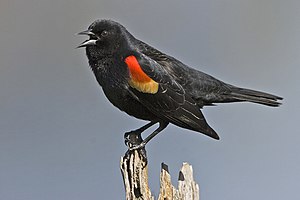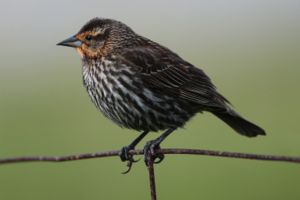Difference between revisions of "Field Guide/Birds/Agelaius phoeniceus"
m (91 revisions: re-import from WB, including edit history) |
|||
| (42 intermediate revisions by 8 users not shown) | |||
| Line 1: | Line 1: | ||
| − | {{ | + | {{Bird id |
| − | |||
| name = Red-winged Blackbird | | name = Red-winged Blackbird | ||
| − | | | + | | latin_name = Agelaius phoeniceus |
| − | | | + | | level = 4 |
| − | | | + | | image_1 = Red winged blackbird - natures pics.jpg |
| − | | | + | | caption_1 = Male |
| − | | | + | | image_2 = Agelaius-phoeniceus-008.jpg |
| − | + | | caption_2 = Female | |
| − | | | + | | range_map = |
| − | | | + | | call = Agelaius-phoeniceus-001.ogg |
| − | | | + | | description =The '''Red-winged Blackbird''', '''''Agelaius phoeniceus''''', is a passerine bird found in most of North and much of Central America. It breeds from Alaska and Newfoundland south to Florida, the Gulf of Mexico, Mexico and Guatemala, with isolated populations in western El Salvador, northwestern Honduras and northwestern Costa Rica. It may winter as far north as Pennsylvania and British Columbia, but northern populations are generally bird migration, moving south to Mexico and the southern United States. |
| − | |||
| − | |||
| − | |||
| − | | | ||
| − | |||
| − | |||
| − | The '''Red-winged Blackbird''', ''Agelaius phoeniceus'', is a | ||
The common name for this species is taken from the mainly black adult male's distinctive red shoulder patches, or "epaulets", which are visible when the bird is flying or displaying. At rest, the male also shows a pale yellow wingbar. The female is blackish-brown and paler below. The female is considerably smaller than the male, at 17-18 cm (7 inches) length and 36 g weight, against his 22-24 cm (9.5 inches) and 64 g. Young birds resemble the female, but are paler below and have buff feather fringes. Both sexes have a sharply pointed bill. | The common name for this species is taken from the mainly black adult male's distinctive red shoulder patches, or "epaulets", which are visible when the bird is flying or displaying. At rest, the male also shows a pale yellow wingbar. The female is blackish-brown and paler below. The female is considerably smaller than the male, at 17-18 cm (7 inches) length and 36 g weight, against his 22-24 cm (9.5 inches) and 64 g. Young birds resemble the female, but are paler below and have buff feather fringes. Both sexes have a sharply pointed bill. | ||
| − | + | The Red-winged Blackbird feeds primarily on plant seeds, including weeds and waste grain, but about a quarter of its diet consists of insects, spiders, mollusks and other small animals, considerably more so during breeding season (Srygley & Kingsolver 1998). In season, it eats blueberries, blackberries, and other fruit. These birds can be lured to backyard bird feeders by bread and seed mixtures. | |
| − | |||
| − | |||
| − | The Red-winged Blackbird feeds primarily on plant | ||
| − | |||
| − | |||
| − | |||
| − | |||
| − | |||
| − | |||
| − | |||
| − | |||
| − | When | + | When migrating north, these birds travel in single-sex flocks, and the males usually arrive a few days before the females. Once they have reached the location where they plan to breed, the males stake out territories by singing. They defend their territory aggressively, both against other male Red-winged Blackbirds and against birds they perceive as threatening, including crows, Ospreys, hawks, and even humans. |
| − | + | The call of this species is a throaty ''check'', and the male's song is scratchy ''oak-a-lee'' (see below). | |
| − | |||
| − | |||
| − | + | Red-winged Blackbirds prefer marshes, but will nest near any body of water. Pairs raise two or three clutches per season, in a new nest for each clutch. The nests are cups of vegetation, and are either built in shrubs or attached to marsh grass. A clutch comprises three to five eggs. These are incubated by the female and hatch in 11-12 days. Red-winged Blackbirds are hatched blind and naked, but are ready to leave the nest ten days after hatching. | |
| − | + | Red-winged Blackbirds are polygynous, with territorial males defending up to 10 females. However, females frequently copulate with males other than their social mate and often lay clutches of mixed paternity. | |
| − | |||
| − | |||
| − | |||
| − | + | When the breeding season is over, Red-winged Blackbirds gather in huge flocks, sometimes numbering in the millions. In some parts of the United States, they are considered to be pests because these flocks can consume large amounts of cultivated grain or rice. This bird's numbers are declining due to habitat loss and the use of poison to prevent this loss of crops. | |
| − | + | Despite the similar names, the Red-winged Blackbird is not related to the European Redwing or the Old World Blackbirdthrushes (''Turdidae''). | |
| − | + | }}<noinclude>[[Category:Adventist Youth Honors Answer Book/Transcluded Modules|{{FULLCHAPTERNAME}}]]</noinclude> | |
| − | |||
| − | [[ | ||
Revision as of 19:09, 5 July 2012
| Agelaius phoeniceus (Red-winged Blackbird) | |
|---|---|
| Description | |
| The Red-winged Blackbird, Agelaius phoeniceus, is a passerine bird found in most of North and much of Central America. It breeds from Alaska and Newfoundland south to Florida, the Gulf of Mexico, Mexico and Guatemala, with isolated populations in western El Salvador, northwestern Honduras and northwestern Costa Rica. It may winter as far north as Pennsylvania and British Columbia, but northern populations are generally bird migration, moving south to Mexico and the southern United States.
The common name for this species is taken from the mainly black adult male's distinctive red shoulder patches, or "epaulets", which are visible when the bird is flying or displaying. At rest, the male also shows a pale yellow wingbar. The female is blackish-brown and paler below. The female is considerably smaller than the male, at 17-18 cm (7 inches) length and 36 g weight, against his 22-24 cm (9.5 inches) and 64 g. Young birds resemble the female, but are paler below and have buff feather fringes. Both sexes have a sharply pointed bill. The Red-winged Blackbird feeds primarily on plant seeds, including weeds and waste grain, but about a quarter of its diet consists of insects, spiders, mollusks and other small animals, considerably more so during breeding season (Srygley & Kingsolver 1998). In season, it eats blueberries, blackberries, and other fruit. These birds can be lured to backyard bird feeders by bread and seed mixtures. When migrating north, these birds travel in single-sex flocks, and the males usually arrive a few days before the females. Once they have reached the location where they plan to breed, the males stake out territories by singing. They defend their territory aggressively, both against other male Red-winged Blackbirds and against birds they perceive as threatening, including crows, Ospreys, hawks, and even humans. The call of this species is a throaty check, and the male's song is scratchy oak-a-lee (see below). Red-winged Blackbirds prefer marshes, but will nest near any body of water. Pairs raise two or three clutches per season, in a new nest for each clutch. The nests are cups of vegetation, and are either built in shrubs or attached to marsh grass. A clutch comprises three to five eggs. These are incubated by the female and hatch in 11-12 days. Red-winged Blackbirds are hatched blind and naked, but are ready to leave the nest ten days after hatching. Red-winged Blackbirds are polygynous, with territorial males defending up to 10 females. However, females frequently copulate with males other than their social mate and often lay clutches of mixed paternity. When the breeding season is over, Red-winged Blackbirds gather in huge flocks, sometimes numbering in the millions. In some parts of the United States, they are considered to be pests because these flocks can consume large amounts of cultivated grain or rice. This bird's numbers are declining due to habitat loss and the use of poison to prevent this loss of crops. Despite the similar names, the Red-winged Blackbird is not related to the European Redwing or the Old World Blackbirdthrushes (Turdidae). | |


